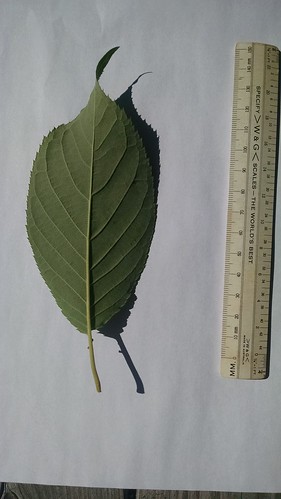Goldenrod leaf
I mentally restricted myself to blogging about tree leaves, but I've been watching for leaf miners since I started and haven't seen any until today and it was in a goldenrod leaf. So I'm writing about a goldenrod leaf (Fig. 1). The plant was near my bus stop and I only had a moment to grab the leaf before the bus came, so I didn't observe any other characteristics about the plant. I'm not sure it would have been possible to identify it more specifically until it flowers anyway. There are a lot of species of Solidago and only a few are really distinctive unless you know them pretty well.
Figure 1. Goldenrod (Solidago sp.) leaf. Upper side is on left. Leaf miner damage visible.
Golderod leaves are lanceolate with a serrate margin. The leaf is light-green above and somewhat silvery underneath. The central vein protrudes under the leaf almost like a midrib.
The leaf miner track starts out around .2mm wide and leads toward the base of the leaf. When it reaches the intersection of a a smaller leaf vein with the middle vein, it turns abruptly, crosses the smaller vein, and heads toward the leaf margin. It runs along the leaf margin until it reaches the base of the leaf, where it reverses direction. The path returns along the leaf margin, but turns inward toward the middle and then meaders back and forth between the margin and the first major vein. There is a black trail inside much of the path, possibly frass or fecal material, The path leads to within a millimeter or two of the beginning and then stops.
- Read more about Goldenrod leaf
- Steven D. Brewer's blog
- Log in to post comments




















